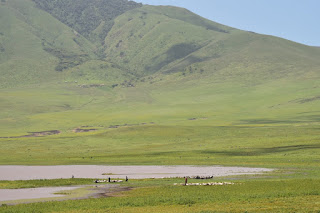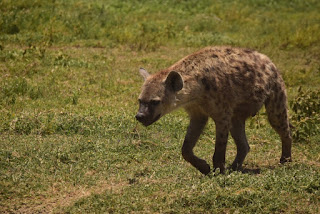Gap Year – Safari – Day 2
After a night at Eileen’s Trees Inn in Karutu – where I am bored into an early night by a pedantic German – we set off for the Ngorongoro Conservation Area. My Swahili lesson is going great guns so while Ally picks up our “permitys”, I chat to other tour guides. They are all very earnest and I decide I easily have the best guide.
We climb up through the thick, luscious woodland of the Ngorongoro Highlands and skirt the rim of the stunning caldera. I haven’t been here since I was 10 but can still remember the breathtaking moment when you see Ngorongoro for the first time. 19.5km across, 8,000 km2 – an idyllic Shangri-La for wildlife. Through our binoculars. we watch some rhinos having sex. It goes on for ages; the couple’s baby rhino stands beside them and waits for them to finish.
We skirt the caldera and set off north-west towards the Serengeti. The Masai are the only people allowed to live in the Conservation Area and we pass drifts of goats and cattle, always with a Masai nearby, leaning on a long stick, checked red “shuka” slung over one shoulder. In one giant herd, I see cows and sheep grazing peacefully alongside wildebeest and zebra – an exquisite sight.

Scenery much like the Scottish Highlands – but with more giraffes – gives way to some Andalucia-style scrub. There are hundreds of zebra and wildebeest, slowly heading south on their 1,000 mile trek, munching as they go – the Great Migration.

We turn off the main track and suddenly we’re on a vast empty plain. Ally tells me this is exactly what the word “Serengeti” means – an endless plain. Gazelles scatter ahead of the jeep, ostriches eye us suspiciously. We see a hyena – Ally’s favourite animal – skulking along beside the road. The hills we’ve descended from slowly diminish and, in the far distance, a line of low bush gets slowly nearer. We reach the scrub and suddenly there are giraffes everywhere, zebras, some adorable dikdiks wobbling their noses at us, guineafowl scuttling out of our way.

We are spending the next two nights at Ndutu Tented Camp perched high above a beautiful lake where we watch hundreds of wildebeest stand at the shore grunting and deciding whether it’s time to cross. Actually, they could easily go round the lake but they are only programmed to cross water, not skirt it. I
I determine that the best sunset view is going to be right by the lake so at 6pm we head down. I neck the last of my Kenya Cane as we watch the sun sink below the low hill on the far side of the lake. Luckily Ally’s a Muslim so I don’t have to share. It’s probably the best sunset of my life.

We climb up through the thick, luscious woodland of the Ngorongoro Highlands and skirt the rim of the stunning caldera. I haven’t been here since I was 10 but can still remember the breathtaking moment when you see Ngorongoro for the first time. 19.5km across, 8,000 km2 – an idyllic Shangri-La for wildlife. Through our binoculars. we watch some rhinos having sex. It goes on for ages; the couple’s baby rhino stands beside them and waits for them to finish.

We skirt the caldera and set off north-west towards the Serengeti. The Masai are the only people allowed to live in the Conservation Area and we pass drifts of goats and cattle, always with a Masai nearby, leaning on a long stick, checked red “shuka” slung over one shoulder. In one giant herd, I see cows and sheep grazing peacefully alongside wildebeest and zebra – an exquisite sight.
Scenery much like the Scottish Highlands – but with more giraffes – gives way to some Andalucia-style scrub. There are hundreds of zebra and wildebeest, slowly heading south on their 1,000 mile trek, munching as they go – the Great Migration.
We turn off the main track and suddenly we’re on a vast empty plain. Ally tells me this is exactly what the word “Serengeti” means – an endless plain. Gazelles scatter ahead of the jeep, ostriches eye us suspiciously. We see a hyena – Ally’s favourite animal – skulking along beside the road. The hills we’ve descended from slowly diminish and, in the far distance, a line of low bush gets slowly nearer. We reach the scrub and suddenly there are giraffes everywhere, zebras, some adorable dikdiks wobbling their noses at us, guineafowl scuttling out of our way.
We are spending the next two nights at Ndutu Tented Camp perched high above a beautiful lake where we watch hundreds of wildebeest stand at the shore grunting and deciding whether it’s time to cross. Actually, they could easily go round the lake but they are only programmed to cross water, not skirt it. I
I determine that the best sunset view is going to be right by the lake so at 6pm we head down. I neck the last of my Kenya Cane as we watch the sun sink below the low hill on the far side of the lake. Luckily Ally’s a Muslim so I don’t have to share. It’s probably the best sunset of my life.

